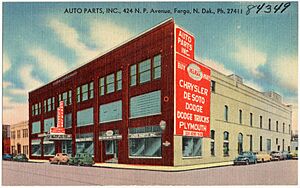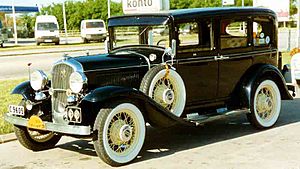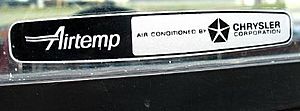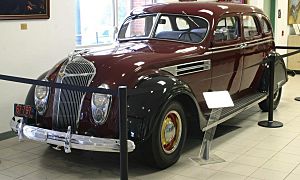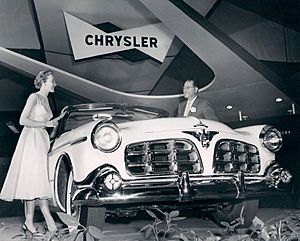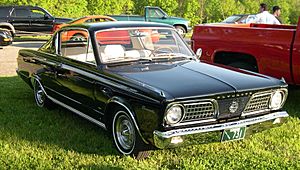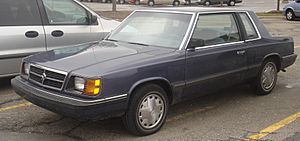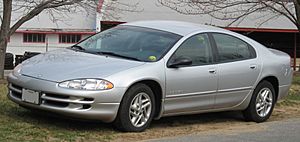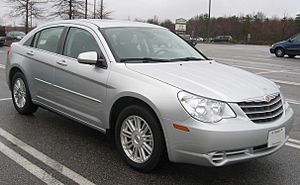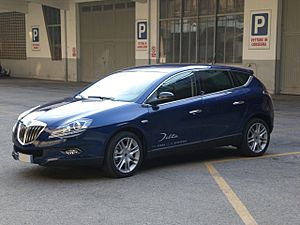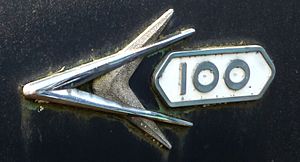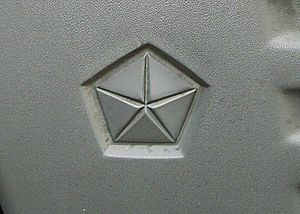History of Chrysler facts for kids
The history of Chrysler is a fascinating story filled with amazing inventions, big business deals, and many changes. Chrysler is a huge car company that began in the 1920s. Today, it's part of a larger company called Stellantis North America.
Contents
- The Story of Chrysler Cars
- How Chrysler Started
- Different Car Brands
- Other Brands and Products
- The Airflow Car
- The Forward Look
- World War II Efforts
- Postwar Government Projects
- The 1960s
- Growing into Europe
- The 1970s
- Turbine Cars
- Lee Iacocca's Leadership
- The 1990s
- DaimlerChrysler (1998–2007)
- Chrysler Sold to Cerberus (2007–2009)
- The 2008 Financial Crisis
- U.S. Government Backing of Warranties
- Bankruptcy and Reorganization
- Chrysler Group
- Chrysler Timeline
- Company Logos
The Story of Chrysler Cars
How Chrysler Started
Chrysler was founded by Walter Chrysler on June 6, 1925. He took over an older company called Maxwell Motor Company and renamed it the Chrysler Corporation.
Walter Chrysler first joined the struggling Maxwell-Chalmers company in the early 1920s. He was hired to fix its problems, just like he had done for the Willys car company before.
In late 1923, they stopped making Chalmers cars. Then, in January 1924, Walter Chrysler launched a new car named after himself. The Chrysler 70 (also called the B-70) was a 6-cylinder car. It was designed to be advanced and well-made, but also affordable for many people.
Cool Inventions and Features
The first Chrysler car in 1924 had many features that most cars didn't have back then. It included an air filter for the engine, a high-compression engine for more power, and a system that kept the engine well-oiled. It also had an oil filter.
Chrysler was a leader in new car technology. They were among the first to use practical four-wheel hydraulic brakes in mass production. They also pioneered rubber engine mounts to make the ride smoother by reducing vibrations. Other inventions included special bearings called Oilite and a process called superfinishing for engine parts.
Chrysler also created a special wheel rim with ridges. This design helped keep a flat tire from coming off the wheel. This important safety feature was later used by car makers all over the world.
After the Chrysler car was introduced, the Maxwell brand was stopped after 1925. A new, cheaper 4-cylinder Chrysler car in 1926 was actually a Maxwell car with a new Chrysler badge.
Thanks to its advanced engineering and testing, Chrysler became the second-best selling car company in the U.S. by 1936. They held this spot again in 1949.
Early Car Models
- Chrysler 70
- Chrysler Touring
Different Car Brands
In 1928, Chrysler Corporation started offering different car brands for different prices and uses. The Plymouth brand was made for the lower-priced car market. It was created by changing Chrysler's 4-cylinder model and giving it a new name.
At the same time, the DeSoto brand was introduced for cars in the middle-price range. Soon after, Chrysler bought the Dodge Brothers car and truck company. They also launched the Fargo line of trucks. By the late 1930s, DeSoto and Dodge divisions swapped places in the company's lineup.
This idea of having many brands under one company might have been inspired by General Motors, which had used a similar successful plan. Starting in 1955, Imperial, which used to be Chrysler's most luxurious model, became its own separate brand. In 1960, the Valiant was also introduced as a distinct brand.
In the U.S., Valiant became a model under the Plymouth brand, and DeSoto was stopped in 1961. With these changes, Chrysler's car lineup from the 1940s to the 1970s, from cheapest to most expensive, was: Valiant, Plymouth, Dodge, DeSoto, Chrysler, and Imperial.
After buying AMC in 1987, Chrysler created the Eagle brand in 1988. These cars were sold at existing AMC-Jeep dealerships. The Eagle brand lasted for ten years and was stopped in 1998. The Plymouth brand ended three years later.
By 2001, and as of 2009, Chrysler had three main brands worldwide: Dodge, Jeep, and Chrysler. In October 2009, a fourth brand was created called Ram. This brand split off from Dodge and focused on trucks like the Ram pickup and Dakota pickup. Later, Fiat became Chrysler's fifth brand in 2011, bringing cars like the Fiat 500 to North America.
Other Brands and Products
MoPar, Chryco, AutoPar
In the 1930s, Chrysler created a special division for car parts called MoPar. This name is a mix of "Motor" and "Parts." Even today, "Mopar" is a common word for cars made by Chrysler.
The MoPar brand was not used in Canada at first. There, parts were sold under the Chryco and AutoPar brands. Mopar slowly started being used in Canada in the late 1970s.
Many Chrysler car parts also had a special DPCD symbol. This stood for Dodge-Plymouth-Chrysler-DeSoto, even after DeSoto cars stopped being made in 1961.
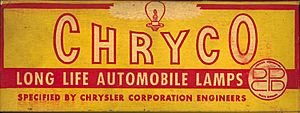
Airtemp
Chrysler also had a brand called Airtemp for air conditioning, refrigeration, and climate control systems. This brand started in 1930 with the first installation in the famous Chrysler Building. The Airtemp Corporation was officially formed in 1934 and used an old Maxwell factory.
Airtemp invented many important things in air conditioning. They created capacity regulators, sealed compressors, and self-contained air conditioning systems. By 1941, they had over 500 dealers selling their products. They were a leader in the industry in the 1940s. However, Airtemp started losing money in the 1970s and was sold in 1976.
Acustar
In the 1980s, Chrysler created a company called Acustar. This company sold parts to other car makers, as well as making parts for Chrysler's own cars. This was similar to what General Motors did with Delphi and Ford did with Visteon.
Safeguard
Safeguard is Chrysler's brand for car glass, both original and replacement. Much of this glass was made at Chrysler's own factory from 1958 to the mid-2000s. Some was also made by other glass companies for Chrysler.
The Airflow Car
In 1934, Chrysler introduced the Airflow models. These cars had a very modern, streamlined shape. They were among the first cars designed using aerodynamics, which is the study of how air moves around objects. Chrysler even built the car industry's first wind tunnel to help design them.
However, people didn't like the Airflow's look. The more traditional Dodge and Plymouth cars helped the company survive the Great Depression. Plymouth was one of the few car brands that actually sold more cars during those tough economic times.
The Airflow's failure made Chrysler's car designs very conservative for a long time. This lasted through the 1940s and into the 1950s. But engineering continued to advance. In 1951, Chrysler introduced its famous Hemi V8 engines.
The Forward Look
Things got better in 1955 with the introduction of Virgil Exner's successful "Forward Look" car designs. In 1956, Chrysler was the first to put transistor radios in cars. On April 28, 1955, Chrysler and Philco announced they had created the world's first all-transistor car radio. This radio was an expensive option on the 1956 Imperial cars.
In 1957, the second generation of Forward Look cars came out with "Torsion-Aire" suspension. This system made the ride smoother and improved how the car handled. However, rushing to build the 1957 models led to quality problems, like poor body fit and early rusting. This, along with a tough economy, meant the company had to recover again.
In 1957, Chrysler also announced electronic fuel injection (EFI) as an option on some 1958 models. But this system was not reliable, and most owners had their cars changed back to carburetors.
World War II Efforts
Military Vehicles and Systems
During World War II, almost all of Chrysler's factories were used to build military vehicles and equipment. Chrysler was one of the top companies in the United States for wartime production. They even made parts for the Manhattan Project, which developed the atomic bomb.
Radar Antennas
One of Chrysler's most important contributions to the war was designing and making parts for radar systems. The SCR-584 was a very important radar system during the war. It had a large, six-foot wide dish antenna that moved in a special pattern.
The Army asked Chrysler's engineering team to help with the final design of this antenna. Chrysler changed the antenna from aluminum to steel, which made it easier to produce using car factory machines. They also redesigned the moving parts using technology from their car gears. These changes made the radar work better, weigh less, and be easier to fix. A large part of the Dodge factory was used to build 1,500 of these radar antennas and the vans they needed.
Postwar Government Projects
After the war, Chrysler continued to work on special projects for the U.S. government. These projects were in the areas of missiles and space rockets.
Missiles
In 1950, the U.S. Army started a missile center in Alabama. A group of German scientists, led by Wernher von Braun, joined them. This group had been brought to America after the war. They designed the Army's first short-range missile, the PGM-11 Redstone, based on the German V-2 missile from WWII.
Chrysler created a Missile Division to be the main company building the Redstone. They set up an engineering office in Alabama and used a large factory in Michigan for production. The Redstone missile was used from 1958 to 1964. It was also the first missile to test a live nuclear weapon.
Working with von Braun's team, Chrysler's Missile Division made the Redstone much more powerful. This led to the PGM-19 Jupiter, a medium-range missile. In 1959, a Jupiter missile launched two small monkeys into space. This was America's first successful flight and recovery of live animals in space.
Space Boosters
In 1959, NASA chose the Redstone missile to be the base for the Mercury-Redstone Launch Vehicle. This rocket was used for short test flights of the Project Mercury spacecraft. It successfully launched the chimpanzee Ham and astronauts Alan Shepard and Gus Grissom into space in 1961.
As America's space plans grew, Wernher von Braun's team designed the Saturn family of rockets. Chrysler's Huntsville operation, now called the Space Division, became the main contractor for the first stage of the Saturn I and Saturn IB rockets. Chrysler built these rockets for the Apollo program at a huge factory in New Orleans.
Between 1961 and 1975, NASA launched many Saturn I and Saturn IB rockets. All of these flights were successful, helping to test the Apollo spacecraft and launch satellites.
The 1960s
Starting in 1960, most Chrysler passenger cars were built with "Unibody" construction. This means the car's body and frame are one piece, making the car stronger and safer. Chrysler was the only one of the "Big Three" American car makers (General Motors, Ford, and Chrysler) to use this method for most of its cars. This design also helped reduce squeaks and rattles as the car got older.
Chrysler's new compact car, the Valiant, sold very well and gained market share for over ten years. The 1960 Valiant was also the first production car to have an alternator as standard equipment. This was a big improvement over older electrical generators. It worked so well that all Chrysler cars used alternators by 1961.
The DeSoto brand was stopped after the 1961 models. This was partly because Dodge cars were becoming very similar in price. This also hurt Plymouth, as Dodge cars started to compete with Plymouth's price range. This problem eventually led to Plymouth being discontinued many years later. A bad decision to make the full-size Dodge and Plymouth cars smaller in 1962 also hurt sales for several years.
To help with rust problems and make sure their Unibody cars stayed safe, Chrysler started using special anti-rust treatments in their 1960 models. They were also the first to use a seven-step rust proofing bath system.
In April 1964, the Plymouth Barracuda was introduced. It was a model based on the Valiant. With its huge glass rear window and sloped roof, it had a very unique look. The Barracuda came out almost two weeks before Ford's Mustang, making the Barracuda the first "pony car". Even so, the Mustang sold much better.
Growing into Europe
In the 1960s, Chrysler expanded into Europe. They bought a majority share in the British Rootes Group in 1964, and also in Simca of France and Barreiros of Spain. Together, these companies formed Chrysler Europe. For the Rootes Group, this led to the launch of the Hillman Avenger in 1970.
During the 1970s, the former Rootes Group faced serious money problems. The Simca and Barreiros parts were more successful, but overall, Chrysler didn't gain much from these European ventures. Chrysler sold these companies to PSA Peugeot Citroën in 1978.
More successfully, at the same time, Chrysler helped create the "muscle car" market in the U.S. They made a street version of their Hemi racing engine. Then they introduced famous high-performance cars like the Plymouth GTX, Plymouth Road Runner, and Dodge Charger. These cars had great success in NASCAR races, which boosted Chrysler's reputation for engineering.
The 1970s
The 1970s were a tough time for Chrysler. Like all American car companies, they relied on a market where gas was cheap. Although Chrysler entered the small car market with the 1971 Dodge Colt, it didn't sell as well as its rivals. As gas prices rose, Chrysler struggled to adapt.
Chrysler's lower sales meant that the cost of developing new cars was a bigger part of each car's price compared to Ford and General Motors. To keep prices down, Chrysler made their engines less powerful to meet new pollution rules. This also meant worse gas mileage when fuel prices were going up.
The 1973 oil crisis greatly reduced demand for large, gas-guzzling cars. These big cars made up most of Chrysler's products.
In the middle of the decade, Chrysler had a big success with its first luxury car, the Chrysler Cordoba. But the rushed introduction of the Dodge Aspen and Plymouth Volaré in 1976 led to huge costs for fixing design flaws and poor quality. This hurt the loyalty people had for the older Dart and Valiant cars.
Chrysler Europe basically fell apart in 1977 and was sold to Peugeot the next year. In 1980, Chrysler Australia was sold to Mitsubishi Motors. The small Horizon/Omni cars came to the U.S. market just as the second gas crisis hit. They sold well, but sales of Chrysler's larger cars were slowing down, and the company didn't have enough strong small cars to rely on.
Turbine Cars
For many years, Chrysler worked on gas turbine engines for cars. These engines can run on many different types of fuel. Chrysler built many test cars with turbines. In the 1960s, it seemed like they might be ready for mass production.
Fifty special Chrysler Turbine Cars were built in 1962 and given to regular people for testing. After more work to meet pollution standards, these engines were planned as an option for the 1977 LeBaron model. However, Chrysler was forced to stop working on the turbine engine. This was a condition for getting special loans from the U.S. government when the company faced financial trouble in the late 1970s.
Lee Iacocca's Leadership
In 1978, Lee Iacocca, who had recently been fired from Ford, was hired as Chrysler's CEO. At that time, Chrysler was losing millions of dollars. Iacocca started to rebuild the company from the ground up. He laid off many workers, sold the money-losing Chrysler Europe division to Peugeot for a very small amount, and brought in many people he had worked with at Ford.
From Ford, Iacocca also brought the idea for the "Mini-Max" project. This project led to the very successful Dodge Caravan and Plymouth Voyager in 1983. Henry Ford II had not wanted to build this minivan at Ford. Hal Sperlich, who was the main person behind the Mini-Max idea at Ford, had also been fired and joined Iacocca at Chrysler. Together, they made automotive history.
Iacocca was also a great public speaker. He appeared in commercials telling customers, "If you find a better car, buy it." He helped bring back pride in American-made products.
The 1980s
Iacocca realized that Chrysler would go out of business without a lot of money to turn things around. So, on September 7, 1979, he asked the United States Congress for $1.5 billion in loan guarantees. Congress agreed, partly because Chrysler workers and dealers feared losing their jobs. The military also bought thousands of Dodge pickup trucks. With this help and some new car models, Chrysler managed to avoid bankruptcy and slowly recover.
After getting this help, Chrysler released the first "K-Car" models, the Dodge Aries and Plymouth Reliant, in 1981. Like the minivan that came later, these small cars were based on designs that Ford had rejected. Since they came out during a major economic downturn, these small, fuel-efficient, and affordable front-wheel drive cars sold very quickly.
Besides small cars, Iacocca brought back the full-sized Imperial as Chrysler's top luxury car. This new model had all the latest technology, including electronic fuel injection and a digital dashboard. Despite some marketing help from Iacocca's friend Frank Sinatra, the new Imperial didn't sell well and was stopped after the 1983 model year.
In February 1982, Chrysler sold its profitable defense part, Chrysler Defense, to General Dynamics for over $300 million.
Chrysler also introduced the Dodge Caravan and Plymouth Voyager minivans in late 1983. These minivans, which were largely Sperlich's idea, led the car industry in sales for 25 years. Because of the K-cars and minivans, and the changes Iacocca made, the company quickly improved. By 1983, Chrysler was able to pay back its government loans years early, making a profit for the U.S. government.
In 1987, it was found that Chrysler had sold about 32,750 cars with their odometers disconnected during test drives. Some cars had been driven as much as 500 miles. Chrysler settled with the people who complained. Iacocca called the action "dumb" and "unforgivable" to try and fix the company's image.
In 1987, Chrysler also formed a joint company with Mitsubishi Motors called Diamond Star Motors. This helped Chrysler in the small car market. They built a new factory in Illinois for the first DSM cars, which came out in 1990.
In the same year, Chrysler bought American Motors Corporation (AMC) for $1.5 billion. Chrysler gained AMC's dealerships and talented engineers. But the main reasons for the purchase were to get the profitable Jeep brand, including the Jeep Grand Cherokee which AMC had almost finished designing. Iacocca really wanted the Grand Cherokee, which came out in 1992.
Another reason was AMC's new Brampton Assembly plant, which was very advanced. This allowed Chrysler to make more cars. Also, AMC's Eagle Premier car became the basis for future Chrysler LH platform sedans. This made Chrysler a bigger company, but AMC also came with $900 million in debt. Chrysler was still the weakest of the "Big Three" car makers.
Chrysler surprised the industry by buying the Italian sports car maker Lamborghini for $25 million. Lamborghini received a cash boost from Chrysler and became more profitable. Chrysler was interested in the "extra premium" sports car market and wanted Lamborghini to make an engine for a Chrysler car in America, which later became the Viper engine.
Chrysler also got involved in designing the Lamborghini Diablo. Although profits increased in 1991, this good fortune was short-lived. In 1992, sales dropped due to an economic downturn. The expensive Diablo car was hard for American fans to buy. With Lamborghini losing money, Chrysler decided it wasn't worth the investment and sold the company for $40 million.
In 1988, Chrysler and Fiat (who owned Alfa Romeo) agreed that Chrysler would be the only distributor for Alfa Romeo in North America. This allowed Chrysler dealers to sell Alfa cars until Alfa left the U.S. in 1995. This first contact between the two companies later led to talks in 1990 about working together. However, these talks eventually broke off. It's interesting that Fiat would later buy a majority share in Chrysler after its restructuring in 2009.
Iacocca received a lot of credit for saving Chrysler from bankruptcy. His commercials made him a celebrity. However, the later part of his time as CEO, from 1988 onwards, was less successful. Buying other companies reduced Chrysler's working money a lot. Also, a project with Maserati (owned by Iacocca's friend) resulted in the Chrysler TC by Maserati, a luxury convertible that was not well-received and cost Chrysler a lot of money.
Iacocca also became more isolated from the managers he had brought from Ford. By 1992, the company's board pushed Iacocca to retire. He stepped down as CEO and Chairman at the end of 1992 and was replaced by Robert Eaton.
The 1990s
In the early 1990s, Chrysler started to return to Europe. They began making cars in Austria and started making right-hand drive Jeep models for the UK market in 1993. The continued popularity of Jeep, new models like the Dodge Ram pickup, the Dodge Viper sports car, and the Plymouth Prowler hot rod, and new "cab forward" front-wheel drive LH sedans put the company in a strong position as the decade ended.
In 1991, Chrysler began moving its main offices from Highland Park, Michigan, to nearby Auburn Hills, Michigan. The move was finished by 1993.
In 1995, former CEO Lee Iacocca helped billionaire Kirk Kerkorian try to take over Chrysler. This attempt was not successful. The next year, Kerkorian and Chrysler made a five-year agreement that stopped Iacocca from talking publicly about Chrysler.
Chrysler was among the companies that faced boycotts from gay rights groups in 1997. This happened after Chrysler removed ads from the TV show Ellen, which they called "controversial."
DaimlerChrysler (1998–2007)
In 1998, Daimler-Benz and Chrysler formed a 50–50 partnership. This was first called a "merger of equals," but it soon became clear that Daimler would take control once Chrysler's CEO, Bob Eaton, retired. Other top executives were soon forced out.
The CEO of Daimler-Benz, Juergen Schrempp, had promised a "marriage made in heaven" with great benefits. But it turned out to be a disaster for Daimler. They put billions of dollars into Chrysler, which used up their management time and money. It also hurt their luxury Mercedes-Benz brand.
The head of Chrysler Group, Dieter Zetsche, was appointed in 2000. The Plymouth brand was stopped in 2001. Plans began to save money by sharing car platforms and parts. After Daimler started selling the Mercedes-Benz Sprinter van in the U.S. as a Freightliner and then a Dodge, the Mercedes-Benz SLK-based Chrysler Crossfire and the Chrysler Pacifica crossover were introduced in 2004. These were the first cars developed together under the merger. The Crossfire didn't sell well, and the Pacifica had problems.
Chrysler also announced a return to rear-wheel drive for a new line of large cars. These included the Chrysler 300, Dodge Charger, and Dodge Magnum. These cars used some Mercedes-Benz parts and offered a new Hemi V8 engine. While the Magnum didn't do great, the 300 and Charger got a lot of attention and sold well. The partnership with Mitsubishi Motors was ended.
Chrysler's financial performance improved, and it made a significant part of Daimler-Chrysler's profits from 2004 to 2005. By 2005, Chrysler was considered the healthiest of the "Detroit Three" car makers (compared to General Motors and Ford).
Because of Zetsche's success at Chrysler, Juergen Schrempp, the CEO of Daimler-Chrysler, was pressured to retire early. Zetsche became CEO of Daimler-Chrysler in 2006, and Thomas W. LaSorda became President and CEO of Chrysler Group. However, in 2006, Chrysler started losing money again. This led to suggestions that the merger would end, as Mercedes wasn't getting any benefits from Chrysler.
Zetsche admitted that Chrysler didn't offer big advantages. He tried to fix Chrysler's problems by cutting production and working harder to make it more competitive. Some people thought Zetsche's time at Chrysler was a mixed success. Chrysler still relied heavily on large SUVs and trucks that used a lot of gas. Most of its new cars were not very successful, even with Mercedes technology.
In 2006, Zetsche even starred in "Dr. Z" commercials, where he played a wise German car expert. The idea was to show that Chrysler had the same German knowledge as Mercedes-Benz. But the campaign was stopped in 2007. After eight years of the merger, most customers still didn't know that Chrysler was owned by the same company that made Mercedes-Benz luxury cars.
Chrysler Sold to Cerberus (2007–2009)
In April 2007, CEO Dieter Zetsche said the company was talking about selling Chrysler. On May 14, 2007, DaimlerChrysler AG announced it would sell 80.1% of its share in Chrysler Group to Cerberus Capital Management for $7.4 billion. Chrysler Group officially became Chrysler Holding LLC (later Chrysler LLC). DaimlerChrysler AG changed its name to Daimler AG.
Chrysler LLC revealed a new company logo, a changed version of the old Pentastar logo, and launched its new website in August 2007. Robert Nardelli became Chairman and CEO. The previous CEO, LaSorda, was given a different role. Jim Press, who used to be president of Toyota Motor Sales, was also appointed to a top position. Cerberus Capital was said to be more interested in making a quick profit than rebuilding the car company for the long term.
The new company had its first labor dispute on October 10, 2007. A strike by the United Auto Workers (UAW) union was planned, but a tentative agreement was reached after just over six hours, ending the walkout.
Chrysler also worked with Tata Motors Limited of India. Tata's electric mini truck was to be sold through Chrysler's GEM division. In February 2008, Chrysler announced it would cut its product line from 30 models to 15. In August 2008, Chrysler was reported to be talking with Fiat.
The 2008 Financial Crisis
In October 2008, Cerberus and General Motors talked about a deal where GM would trade its share in GMAC for Chrysler. This could have merged two of Detroit's "Big Three" car makers. But these talks didn't work out. On October 24, 2008, Chrysler announced it would cut 25% of its salaried workers (5,000 jobs).
Michigan Governor Jennifer Granholm and other governors asked the U.S. government for emergency money for the Detroit "Big Three" car makers. On the same day, General Motors asked for $10 billion to help both their company and possibly Chrysler.
On October 23, 2008, Daimler announced that its share in Chrysler was worth zero dollars after financial write-offs.
On November 5, 2008, it was reported that Chrysler sales in the U.S. had fallen by 34.9% in just 12 months. A week later, Chrysler CEO Robert Nardelli said the company could only survive by forming an alliance with another car maker and getting government help. Several days later, Chrysler, along with Ford and General Motors, asked for financial aid at a Congressional hearing in Washington D.C. All three companies were unsuccessful at first and were asked to create a new plan to survive.
In early December 2008, during the 2008 car crisis, Chrysler announced it was dangerously low on cash and might not survive past 2009. After a bill to help car makers failed in the Senate, Chrysler said it would likely file for bankruptcy and close all operations. On December 17, 2008, Chrysler announced it would stop production at all 30 of its factories until January 19, 2009.
On December 19, President George W. Bush announced a $13.4 billion rescue loan for American car makers, including Chrysler.
Chrysler's sales in 2008 were hit hard. On March 13, 2009, LaSorda said that Chrysler would need to cut hourly wages by $20, breaking a pattern set by GM. He suggested Chrysler might leave Canada if it couldn't get more cost savings from the Canadian Autoworkers union. Fiat CEO Sergio Marchionne also threatened to walk away from a possible merger if the union didn't agree to wage cuts. The union eventually agreed.
On March 7, 2009, Chrysler Vice-Chairman Jim Press said that current sales were enough to keep the company going. He also noted that Chrysler's February retail sales were better than Ford's.
On March 30, 2009, the White House announced it would give Chrysler an additional $6 billion in support. This was dependent on Chrysler finalizing an alliance with Fiat by the end of April.
U.S. Government Backing of Warranties
On March 30, 2009, President Barack Obama announced that the U.S. Government would guarantee Chrysler's car warranties. He publicly stated that the government would back the warranties on Chrysler vehicles even if the company went out of business.
Bankruptcy and Reorganization
On January 20, 2009, Fiat S.p.A. and Chrysler LLC announced they had a plan to form a global alliance. Fiat could take a 35% share in Chrysler. In return, Fiat would give Chrysler access to its car platforms to build smaller, more fuel-efficient cars in the U.S. Chrysler would also get access to Fiat's global distribution network.
By mid-April, as talks continued, Fiat's initial share was reported to be 20%. However, Fiat warned that the merger would not happen if Chrysler didn't reach an agreement with its unions. On April 26, 2009, Chrysler announced it had reached a deal with the unions that met government requirements.
Chrysler filed for chapter 11 bankruptcy protection on April 30, 2009, and announced its alliance with Fiat.
Both the White House and Chrysler hoped for a quick bankruptcy, lasting 30 to 60 days. The goal was to reduce the company's debts and emerge in stronger financial shape. The government said it would provide between $3 billion and $3.5 billion in funding during the bankruptcy. After the restructuring, Chrysler could receive up to $4.5 billion to restart operations, for a total of $8 billion in government support. Before filing for bankruptcy, Chrysler had already received $4.5 billion from the U.S. government in December 2008.
Chrysler announced that during the restructuring, it would stop most manufacturing operations on May 4, 2009. Production was expected to restart within 30 to 60 days.
On May 1, 2009, Chrysler LLC filed for bankruptcy, and LaSorda retired.
On May 14, 2009, Chrysler asked the bankruptcy court to end agreements with 789, or about 25%, of its dealerships.
On June 1, 2009, a U.S. bankruptcy court approved a plan for the new Chrysler company, called "Chrysler Group LLC." A trust fund for retired union workers would own 55%. Fiat would own 20%, and the U.S. (8%) and Canadian (2%) governments would hold smaller shares. Fiat said it planned to increase its share to 35% if Chrysler met certain goals.
On June 9, 2009, the Supreme Court allowed the sale of assets to "New Chrysler" to go forward. The U.S. Department of the Treasury said that no court found any fault with how Chrysler or the U.S. government handled the matter. The sale was set to close on June 10, 2009. Fiat would receive ownership in the New Chrysler by providing car platforms for new Chrysler cars.
On June 10, 2009, 41 days after filing for bankruptcy, the sale of most of Chrysler's assets to "New Chrysler," formally known as Chrysler Group LLC, was completed. The federal government provided $6.6 billion in funding to the "Old Chrysler."
The transfer did not include eight manufacturing locations, many properties, or equipment leases. Contracts with 789 U.S. car dealerships, which were being dropped, were also not transferred.
Fiat initially owned a minority 20% share of Chrysler Group LLC. They had the option to take more ownership, up to 35%, if Chrysler met certain goals. The union's retiree health care trust fund was the majority owner, with 55%, once Fiat reached its 35% goal. The U.S. and Canadian governments initially held smaller shares of 8% and 2% respectively.
On May 24, 2011, Fiat paid back $7.6 billion in U.S. and Canadian government loans. On July 21, Fiat bought the Chrysler shares held by the United States Treasury. With this purchase, Chrysler was once again owned by a foreign company; this time, the Italian car maker Fiat gained majority ownership and control. The U.S. government's involvement in the Chrysler bankruptcy cost U.S. taxpayers $1.3 billion.
Chrysler Group
In early 2009, Chrysler Group, based in Auburn Hills, Michigan, became mostly owned by the United Auto Workers union's trust. In June 2009, Fiat gained ownership of Chrysler Group as part of Chrysler's restructuring plan. Eventually, Fiat gained a total of 58% ownership in the company.
Fiat announced plans for the Chrysler brand and Lancia to work together on products, with some cars being shared. Olivier Francois, Lancia's CEO, also became CEO of the Chrysler division in October 2009. Fiat stated that, depending on the market, some Chrysler cars would be sold as Lancias and vice versa. Francois planned to make the Chrysler brand an upscale, more luxurious brand again.
At the 2010 Detroit Auto Show, a Chrysler-badged Lancia Delta was shown. This was likely the first Lancia to be sold as a Chrysler. Dodge, Jeep, and Chrysler all received makeovers, with every car and truck being updated, redesigned, or replaced.
On December 16, 2014, Chrysler Group LLC announced it was changing its name to FCA US LLC.
Chrysler Timeline
- Maxwell Motor Company (1904–1925)
- Chrysler Corporation (1925–1998)
- DaimlerChrysler AG (1998–2007)
- Chrysler LLC (2007–2009)
- Chrysler Group LLC (2009–2014)
- FCA US LLC (2014–2021)
- Stellantis North America (2021–present)
Company Logos
Medallion Logo
When Chrysler started in 1925, its logo was a round medallion with a ribbon. The ribbon had the name CHRYSLER in big letters.
Forward Look Logo
Virgil Exner's new "Forward Look" designs for Chrysler cars in 1955 were highlighted by a new company logo with the same name. The Forward Look logo had two overlapping boomerang shapes. These shapes were meant to look like rockets moving in the Space Age.
Pentastar Logo
As the Forward Look car designs were ending, Chrysler President Lynn Townsend wanted a new logo. This logo could be used by all of Chrysler's companies and divisions around the world, for cars and other products. He wanted something that people would immediately recognize as Chrysler's mark, no matter where they were.
In September 1962, the company adopted a logo called Pentastar. It was made of five triangles arranged so their bases formed the sides of a pentagon. The spaces between the triangles formed a star in the middle. The Pentastar was simple and easy to recognize, even on spinning signs. It wasn't tied to any specific car design, unlike the previous Forward Look logo. Because the symbol had no words, it helped Chrysler expand into international markets. The Pentastar was widely used on dealer signs, ads, brochures, and on Chrysler products themselves.
Chrysler-Plymouth materials used a blue Pentastar or a white one on a blue background. Dodge used a red Pentastar or a white one on a red background.
Other brand logos, like Dodge's Fratzog, were slowly phased out. By 1981, all Chrysler divisions used only the Pentastar. All car brands and other Chrysler services—like air conditioning, heating, industrial engines, and car parts—were identified by the Pentastar.
The Pentastar logo was placed on the lower passenger-side fender of all Chrysler products from 1963 to 1972. It was put on the passenger side so people walking by could see it easily. This was a clever way to make the symbol stick in people's minds. A name has to be read, but a symbol is quickly recognized. So, cars driven on the right side of the road had the Pentastar on the left fender, and cars driven on the left side had it on the right. Starting in the 1980s, hood ornaments on Chrysler-brand cars used a gem-like version of the Pentastar to show the brand's upscale status.
The Pentastar's last appearance as a badge on a car was on some rare versions of the 1996 Plymouth Voyager. It was also on the steering wheel, keys, and fenders of the Voyager and other Chrysler minivans until 2000.
The Pentastar continued to represent Chrysler until the merger with Daimler in 1998, when it was retired. Some traces of this symbol still remain, like a large, star-shaped window at Chrysler's headquarters in Auburn Hills, Michigan. Many dealerships still have signs and other things with the Pentastar. A five-Pentastar logo is still used for the "Five Star Dealer" service rank.
Even though it was officially retired under Daimler, the Pentastar continued to be used as the identifying mark on Chrysler Group parts. You can see it on car windows, individual parts, and larger parts like engine blocks.
The Pentastar was officially brought back in 2007. However, it was replaced with the letters "FCA" for Fiat Chrysler Automobiles in 2014. Even though Chrysler is now part of Stellantis since 2021, the Pentastar logo is still on the headquarters building.
The Pentastar is also used as the badge of the United States Army's V Corps.
Return of Brand Logos
Individual brand logos started to replace the company-wide Pentastar in the early 1990s. The Dodge division began using a ram's-head logo starting with the 1993 Intrepid and Spirit. The Chrysler brand started using a medallion based on its original logo in 1995. This logo was put on all Chryslers by 1996. That same year, Plymouth adopted a new sailboat logo, which was a simpler version of the brand's old Mayflower ship logo.
Winged Logo
The design shown here is an updated version of the original medallion logo that Chrysler used on its cars when it started in 1925. This logo was brought back for the Chrysler brand in 1996. It is often surrounded by a pair of silver wings. When Chrysler was sold to Cerberus, the company brought back the Pentastar as its main corporate logo. However, the winged logo is still used on the cars themselves.
Pentastar Revival
On May 17, 2007, an internal email said that Chrysler would bring back the Pentastar logo in an updated form after their split from Daimler. The new three-dimensional Pentastar was officially introduced when Chrysler LLC became a private company in August 2007. Chrysler cars kept a changed version of the winged logo.
Pentastar Removed
With the creation of Fiat Chrysler Automobiles in 2014, the letters "FCA" replaced the Pentastar as the official logo. This change made some Chrysler fans upset, and they started a Facebook page and a petition to save it.


